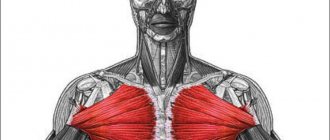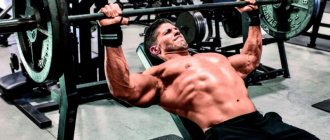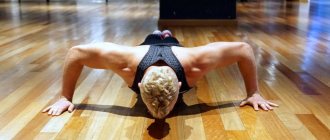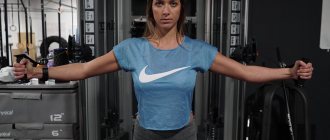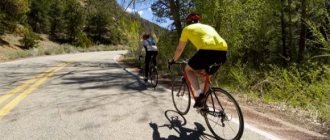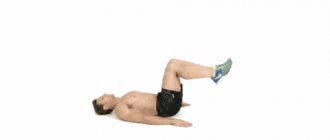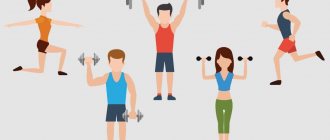How to pump up your breasts
Only a person whose pectoral muscles are well trained and pumped up can play beautifully with their pectoral muscles. An untrained man cannot feel or control them, so the first thing to focus on is creating sculpted muscle mass.
It is necessary to develop the whole body evenly, but in this case exercises will be described that are aimed primarily at the pectoral muscles.
Best exercises
To get quick results, you need to focus on the problem area. There are several of the most effective exercises that will help you quickly create the desired volume in your chest. And while doing them, you will be able to feel the necessary muscles in action.
Listen carefully to your sensations - to move any muscles you need to create a load on them. Just understand how to move to contract a particular part of the chest, and you will quickly master this skill.
The best exercises for chest development:
- Pushups.
- Bench press.
- Lying dumbbell fly.
- Information on blocks.
Start working with light weights and gradually increase them. First of all, focus on the execution technique and accustom your muscles to the load. Working with a lot of weight at once can cause you to strain yourself or get injured.
The most effective thing is the bench press with a barbell.
If you are new to the gym, be sure to contact an instructor. He will help you choose the right load and teach you how to perform the exercises correctly. After all, if you do them with errors, you will not achieve the desired result. And in the worst case, you can even get injured.
Load on different parts of the chest
The pectoral muscles are located on the front wall of the chest and extend to the tubercle of the humerus. Conventionally, the breast can be divided into 4 areas:
- top;
- lower;
- external;
- internal.
For beautiful breasts, you need to apply the load evenly to all parts. For some areas you need to perform the exercises with slight modifications. Keep this in mind if you are not satisfied with the appearance of your breasts.
The famous fitness instructor Denis Semenikhin in the video below will tell you how to properly pump up this or that area of the chest.
The outer and inner chest areas develop well when performing the most popular exercise - the bench press with a barbell. But you need to take into account the position of your hands:
- The wider the grip, the greater the load on the outside.
- The narrower the grip, the greater the load on the internal one.
When performing this exercise, the lower edge of the chest is also perfectly worked out; the main thing is to work on a flat horizontal surface.
The inner chest works well during blocking at the point where the hands are as close to each other as possible. In the maximum diluted state, the outer part works. Stay at these extreme points for a while to give additional stress to the desired areas.
The upper extrinsic muscles are worked during lying dumbbell flyes. By changing the inclination of the bench, you can give additional stress to the area with which you have problems:
- an inclination of 20-30 degrees helps to pump up the middle of the chest;
- when tilted at 40-50 degrees, the upper chest works.
Try to use different exercises during your workouts so that your pectoral muscles develop evenly.
Optimal training frequency
Wanting to quickly learn how to move their pectoral muscles, men make a common mistake - they exercise every day. But you will get the results of your training not during classes, but between them.
The optimal frequency of strength training is no more than once every 72 hours or 2 times a week. Otherwise, the muscles simply will not have time for recovery and subsequent growth.
During training, listen carefully to the sensations and watch the body's reaction, then later you will be able to contract your muscles at will.
Training program for beginners
The main emphasis for beginners is always on basic exercises in the training program, because they are the ones that most quickly stimulate muscle growth .
Basic exercises, they are also multi-joint , that is, they involve two or more joints in their execution. Such exercises include, first of all, for the pectoral muscles - bench press on a horizontal bench, for the legs - squats with a barbell on the shoulders, for the back - pull-ups on the bar with a wide grip, in general for the back and legs - deadlift (this is the only exercise strength is judged by the strength indicators in a given exercise ).
4 exercises will be enough for you to increase muscle mass by an average of 7-8 kg .
In addition to the basic ones, there are also isolating exercises, they are less effective for beginners, they involve one joint , and load one muscle group; in the training program we will use them as an addition, and nothing more.
Training program for beginners
Construction of training cycles
The general principle of constructing a training cycle is as follows: for each workout the whole body (major muscle groups) is pumped, the only difference is in the training stress , which will vary depending on the intensity of the exercises, so each basic exercise will have a signature - if it’s light, that means working weights are 60-65% of the maximum, if it’s medium, that means working weights are 70-75% , if heavy it means 80-85% .
We will be interested in strength indicators only in basic exercises, due to the fact that it is by them that we can judge our training progress (as strength increases, so will mass).
In turn, isolation exercises into account, because they are used as a “ auxiliary exercise ” and nothing more, so to speak, to add variety to the training program.
Thus, the training cycle will consist of heavy , medium and light training, the gradation goes to basic exercises. bench press on Monday (80-85%), then on Wednesday it will be medium (70-75%), and on Friday light (60-65%), and all over again, Monday bench press heavy, medium on Wednesday, and light on Friday. The same applies when planning loads in deadlifts and squats with a barbell .
Recovery phases after regular training
A cyclic approach to training will ensure full recovery , as well as the maximum rate of muscle mass growth, by adapting muscles to the load, by increasing their size.
Exercise program for gaining mass
This training program has a pronounced cyclical nature (as we wrote about above), with an emphasis on basic exercises. It is very suitable for beginners for gaining weight.
Monday
- Squats with barbell 4x8 (medium)
- Bench press 5x6 (heavy)
- Dips 4x8
- Barbell curl for biceps 3x12
- Press crunches 2x50
Wednesday
- Deadlift 4x8 (medium)
- Bench press 3x12 (light)
- Dumbbell bench press 4x8
- Standing barbell press 4x8
- Seated dumbbell biceps curl 4x8
- Hanging straight leg raises 4x20
Friday
- Squats with a 3x12 barbell (light)
- Bench press 4x8 (medium)
- Lying dumbbell flyes 4x8
- French bench press 3x12
- Pull-ups on 4x8 bar
- Bench crunches 2x50
The first number is approaches, the second is repetitions.
Strength training program to gain muscle mass
Three workouts per week, each lasting no more than 2 hours , rest between sets 2-3 minutes , between exercises can be increased to 5-7 minutes . the working weights as quickly as possible , try to strictly adhere to the technique of performing the exercises, feel how the muscles work, their filling with blood.
Symptoms
Victim: - When I got to the 250 kg mark, after training I began to notice severe, deep-localized soreness in the tendons of my pectoral muscles. No matter what I did, the pain did not go away. Sometimes I had to take up to 10 days between workouts.
I felt pain when lifting a weight of only 7 kg. Now I am absolutely sure that all these years I suffered from constant microtrauma and calcification of muscle tissue, or at least from its replacement with more durable scar tissue.
I continued to experience these symptoms despite regular courses of heat, ice, ultrasound, aspirin, other anti-inflammatory drugs (such as cortisone injections), massage and other treatments.
On the other hand, other bodybuilders may have the same disorders but WITHOUT THE SAME SYMPTOMATICS. This is why so many pectoral muscle tears occur completely unexpectedly.
Sometimes even all the knowledge and medical measures do not help and you still get injured in one way or another. Most, if not all, bodybuilders who have been victims of a difficult muscle tear have done everything that is usually recommended to prevent it, consistently changing weight, taking breaks, using high reps, stretching, undergoing medical or surgical treatment, etc., however , were still injured. Let's face the facts. Heavy bench presses are not necessarily good for the tendons, joints and chest muscles. The more often the heavier the weight you press, the greater your risk of tearing the pectoral muscle! That's right, it's that simple.
Rehabilitation after surgical treatment of a torn pectoralis major muscle.
The rehabilitation protocol is largely based on clinical knowledge and previous research in the field of healing of soft tissues, such as the Achilles tendon, as existing studies on the biomechanics of the sutured pectoralis major tendon are not sufficiently evidence-based.
As with other injuries, the postoperative protocol for injuries to the pectoralis major muscle includes: maintaining the structural organization of the tissue being restored, gradually increasing the range of motion, restoring dynamic control, and resuming full physical activity.
0-2 weeks.
Main goals: protection of the regenerate, reduction of swelling and pain, reduction of the harmful effects of prolonged immobilization. If the tendon was sutured rather than reinserted, this requires a more gradual and lengthy rehabilitation. For the first 4 weeks after surgery, only passive movements in the shoulder joint are performed, active movements in the elbow and wrist joint are allowed. Passive movements should be performed by a rehabilitation physician or a specially trained exercise therapy instructor. Flexion starts at 10°, and increases by 5-10° each week. External rotation starts at 5° and increases 5-10° each week. To combat pain and swelling, cryotherapy and high-voltage galvanic electrical stimulation are used. Mobilization of the postoperative scar and its careful massage will avoid the formation of a rough scar and ensure good mobility of the surrounding soft tissues.
After healing of the skin wound, the patient gradually increases the amplitude of pendulum-like movements in the shoulder joint, under the supervision of a physical therapy doctor. Pendulum movements are an important part of subsequent home rehabilitation.
2-4 weeks.
Starting from week 3, exercises are introduced to increase the volume of active assisted movements, including using a gymnastic stick, but abduction and external rotation in the shoulder joint should be excluded. The patient also begins isometric tension of the muscles of the shoulder girdle, which allows you to begin to restore control and strength of the muscle. The patient can begin cardiovascular exercise, but must be advised to maintain strict balance to avoid falling and re-injury.
4-6 weeks.
At week 5, the patient continues to gradually increase the range of active-assisted movements in the shoulder joint. The volume of passive movements should be ahead of the volume of actively assisted ones; at this stage, exercises using a gymnastic stick continue, exercises for abduction and external rotation are gradually introduced, starting from 30° and increasing by 5-10° every week.
The picture above shows abduction 90 ̊ and external rotation 90 ̊, this amplitude is achieved by the end of the 8th week.
It is necessary to remember the high risk of rerupture, overstretching of the regenerate, loss of attached muscle tissue in case of violation of the load regime and an excessively rapid increase in the amplitude of movements at this stage of rehabilitation. By the end of the 6th week, the patient is allowed to begin careful active movements in the shoulder joint, to the extent that pain allows.
Also, by the end of the 6th week, exercises for the scapular muscles are added. Rotation of the shoulders in different directions, accompanied by sliding of the scapula along the surface of the chest. You can add a small isometric load, but it should not exceed 1-2 kg. It is possible to perform exercises on other muscle groups of the shoulder and shoulder girdle, excluding tension in the pectoralis major and biceps muscles.
6-8 weeks.
Exercises are continued aimed at increasing the range of movements, with the goal of achieving full amplitude by the end of the 8th week. It is necessary to control the correct kinematics of the shoulder joint; movements should be performed precisely at the expense of the shoulder, and not at the expense of the scapula.
8-12 weeks.
Exercises are added aimed at developing dynamic stabilizers and the rotator cuff, for example, holding a light dumbbell (0.5 kg) in a position abducted to 30°-90°. Another good exercise for developing dynamic stabilizers is proactive training. The patient is in a supine position, the arm is flexed at the shoulder joint up to 90°, the physical therapy doctor makes light pushes of the arm, the patient returns it to its original position, as if overcoming the action of destabilizing forces. The speed, strength and amplitude of the pushes gradually increases to 20°; you can complicate the exercise by closing the patient’s eyes.
Spiral and diagonal movements in the shoulder joint are added.
You can begin resistance exercises using a rubber band, abduction, flexion, external rotation with light resistance.
Exercises continue to hold the arm in abduction position up to 30°-90°, you can gradually increase the weight to 2.5-5 kg.
12-16 weeks.
The final stage of rehabilitation, aimed mainly at restoring the strength and endurance of the pectoralis major muscle. By this point, the full range of both passive and active movements in the shoulder joint should be achieved. It is recommended to use exercises with plyoball).
Only at this stage can bodybuilders and powerlifters begin bench pressing with an empty bar. The increase in load should be gradual and designed to fully restore to the “working weight” level by the end of the 6th month (i.e. within 3 months or 12 weeks). Also at this stage, exercises using modern dynamometer devices such as Biodex and Cybex have proven themselves well. It is necessary to clearly explain that working with a weight of more than 50% of the maximum approach is unacceptable until 6 months. Working at a competitive level places tremendous stress on the pectoralis major tendon and is not permitted until 12 months after surgery.
Training program
You can pump up your internal muscles only through regular and consistent training.
A sample twice-weekly training plan looks like this:
- whole body warm-up + orbitrek 5 minutes;
- bench press – 3-4 sets of 8-12 repetitions;
- butterfly - 3-4 sets of 12-15 repetitions;
- Bench press with a narrow grip – 3-4 sets of 8-12 repetitions;
- mixing in crossover on lower blocks - 3-4 sets of 12-15 repetitions;
- Svend press - 3-4 sets of 12-15 repetitions.
At the end of the workout, you should stretch the chest area for 5 minutes and perform a so-called muscle cool-down. This program can be used for 2 months, after which it needs to be modified.
In conclusion, it is worth noting that it is impossible to achieve impressive results by training your chest at home. Improve your structure, make your muscles toned, yes, but becoming a guy on the cover of a magazine is unlikely, unless of course you have your own gym at home.
Good luck in your training, beautiful body and good health!
BASIC PRINCIPLES OF REHABILITATION
Here is the order of basic actions for a torn chest muscle:
1) Immediately isolate your hand from movement and apply ice to the injury site.
2) Hold your hand as high as possible.
3) See a doctor as soon as possible, even if it means a trip to the emergency room.
4) Wear an immobilization bandage as directed by your doctor.
5) As directed by your doctor, slowly water the stretch in all directions. In this case, warming up and additional developmental movements should be used.
• To speed up recovery, massage is suitable.
• Begin recovery training using only very light weights and high repetitions.
• Gradually move on to direct exercises, gradually increasing the working weight.
• If soreness persists, apply ice to the injury after exercise.
• Make sure your diet always has enough minerals, protein and vitamins.
• If you are a bodybuilder, then do not forget that the bench press is not the only way to increase the size of the pectoral muscles.
Most of you are familiar with the basic treatments for sprains and other minor injuries: rest, ice, compression and elevation. Here is a short reminder for those who have not yet encountered injuries or for those who simply want to avoid trouble:
• REST - Leave the injured area alone.
• Apply ICE to it (for 20 minutes, then remove it for 10 minutes and repeat the sequence from the beginning). In addition, ice is good for bruises (inevitable from a fall or in contact sports).
• COMPRESSION of the injured area is done using special bits, tightly but not so much as to interfere with blood circulation.
• Elevation of the injured area serves to prevent hematoma formation.
Don't delay! Follow these recommendations immediately after receiving an injury, and you will minimize its unpleasant consequences and may be fully functional the very next day.
If not, consult a doctor immediately.
Pump up your muscles
Mistakes of a beginner bodybuilder
The well-known saying , whoever makes no mistakes, does nothing, is just right for all novice bodybuilders. Everyone will go through injuries, sprains, pain in muscles, ligaments, tendons in the gym, but all the negative consequences of strength training can be minimized if you approach wisely . Learn from other people's mistakes, not your own.
Exercising with iron (weights) is a fairly new phenomenon, but more than a dozen years have already passed since the era of bodybuilding , when Arnold Schwarzenegger forged his muscles in the gym, and opened the doors for all people to a new, unknown type of strength sport , bodybuilding. Over the course of this time, a certain experience has developed that has allowed all athletes not only to minimize injuries during training, but also to avoid popular mistakes that beginners in the gym very often make.
Below we will tell you about the most popular mistakes that beginners make in the gym, as well as ways to eliminate them.
Mistakes of a beginner bodybuilder
Ignoring a warm-up before doing an exercise
Remedy: depending on the exercise, it is necessary to warm up the muscles being trained by performing specific warm-up exercises, as well as using a warming ointment for training.
What is the danger of a mistake: the occurrence of various injuries during training is inevitable - sprains and ruptures of muscles/tendons.
Ignoring a warm-up before performing a working approach
Lack of methodology (training program)
Remedy: find a training program in any way (ask a friend, a fitness instructor, search the Internet). Another question is whether it will work, and if so, how? In turn, we offer you our working training programs, depending on the athlete’s level of preparedness.
What is the danger of an error: By and large, any training program will work, sometimes less, sometimes more, but in the absence of a training plan , that is, thoughtlessly performing exercises, will only lead to negative or zero results.
Lack of a systematic approach to the training process
Poor (incorrect) nutrition of an athlete
Remedy: Accustom yourself to eat small, multiple meals (6-7 meals a day), and most importantly, your list of products should be of high quality , without preservatives, GMOs, also give up fast foods, which are nothing but “empty” calories and harmful have no impact on the body.
Proteins must be of high biological value - seafood, fish, eggs, cottage cheese, milk, etc. Carbohydrates are mostly complex, especially for people who are prone to obesity - potatoes, rice, pasta, cereals and more; read more about the rate of conversion of carbohydrates into glucose in this article. Fats should be unsaturated, that is, omega 3 and 6 fatty acids.
What the error entails: lack of progress in training. Malnutrition, a low-calorie daily diet will not allow you to gain muscle mass. Excess junk food and empty calories can cause immune system and obesity.
Harmful foods in the human diet
No full recovery (rest)
Remedy: 8-9 hours of sleep, balanced, nutritious nutrition, well-thought-out training, cycling and frequency of strength training in the gym.
Healthy, adequate sleep is the key to your full recovery, and alternating light, medium and heavy intensity training is the key to successful progress in gaining strength and muscle mass. Nutrition in this matter will be a source of fuel, an energy component that will help accumulate strength for training.
The dangers of a mistake: overtraining, loss of strength, loss of muscle mass, increased susceptibility to various injuries during training, diseases due to decreased immunity, as well as depressed consciousness, loss of motivation for further bodybuilding.
Poor athlete recovery
A frivolous approach to bodybuilding
Remedy: a serious, responsible approach to your training, nutrition and recovery. As a rule, many athletes, especially beginners, have enough sense of purpose and focus on results. 1-2 years of regular training in the gym, subject to proper nutrition and rest, can change your body beyond recognition.
Any, even the most insignificant things, determine your consciousness , how you do it, whether you give your all in training, or say to yourself “it will do.”
Actions and actions determine a person, not thoughts, everyone wants to be a champion , to have a beautiful, sculpted body, but few people are able to endure muscle pain, limit themselves in food, not skip workouts, “plow” in the gym for the sake of their goal in the gym hall
What a mistake can cause: lack of results in bodybuilding, injuries during training, the appearance of obsessive thoughts like “all the jocks are pumped up on steroids.”
A relaxed approach to training
Treatment
In case of local separation, treatment begins with immobilization and fixation of the affected area. The traumatologist applies a plaster cast to bring the torn edges closer together (this will speed up recovery). If the rupture is complete, then surgery is required, after which fixation and immobilization are performed.
Surgical sutures are required. Recovery takes one and a half or two months, depending on the severity of the pathology. During rehabilitation, you need to visit a specialist to perform physical procedures, as well as independently perform therapeutic massage.
Prevention
The main way to avoid injury is to use warming ointments and warm up thoroughly before physical activity. It is necessary to correctly time under load to avoid significant damage. Additionally, you need to carry out therapeutic massage and get plenty of rest to ensure 100% recovery of the body. It is also imperative to consume a sufficient amount of carbohydrates, proteins and fats, and during intense physical activity, take a vitamin-mineral complex.
Our clinic employs experienced traumatologists who are able to make a diagnosis based on palpation, determining the presence of a gap between the ends of the affected muscle. If the gap is partial or closed, instrumental diagnostic studies are performed, including ultrasound.
Do not self-medicate - contact traumatologists at the CELT clinic, and your full recovery is guaranteed!
Orthopedics and traumatology services at CELT
The administration of CELT JSC regularly updates the price list posted on the clinic’s website. However, in order to avoid possible misunderstandings, we ask you to clarify the cost of services by phone: +7 (495) 788 33 88
| Service name | Price in rubles |
| Appointment with a surgical doctor (primary, for complex programs) | 2 700 |
| Ultrasound of soft tissues, lymph nodes (one anatomical zone) | 2 300 |
| MR tomography of soft tissues (one anatomical area) | 6 000 |
Make an appointment through the application or by calling +7 (495) 788-33-88 We work every day:
- Monday—Friday: 8.00—20.00
- Saturday: 8.00–18.00
- Sunday is a day off
The nearest metro and MCC stations to the clinic:
- Highway of Enthusiasts or Perovo
- Partisan
- Enthusiast Highway
Driving directions
Reduce the amount of subcutaneous fat
No matter how pumped and developed your pectoral muscles are, no one will be able to see their movements under a layer of fat. Even with a normal weight, the chest will look round and too voluminous.
The optimal level of subcutaneous fat is 7-10%. With this indicator, you will have a sculpted body, where every muscle and every movement is visible.
It is not recommended to go below 5% - it is harmful to health.
How to dry your body
Perform the exercises described at the beginning of the article, and at the same time change your diet. You cannot starve or go on strict diets, because in this case muscle mass will suffer. And you worked so long to develop it. To get rid of fat, you need to follow the following rules:
- Avoid fast carbohydrates. To achieve a beautiful figure, you will have to give up sweets, baked goods, fast food, carbonated drinks, chips and other junk food.
- Complex carbohydrates until 2 pm. You cannot completely give up carbohydrates, because they are necessary for the normal functioning of the body. The main thing is to consume them in the first half of the day and in small volumes - 1 g per 1 kg of weight.
- Limit fats - don't give them up completely, but reduce them to a minimum.
- Eat more protein – To develop muscle mass and gain strength, you need to eat more protein foods. These products include eggs, lean meat, fish, legumes, and low-fat dairy products.
After consulting with your doctor, you can take fat-burning medications. The main thing is to follow the instructions and do not violate the specified dosage.
Soon your pectoral muscles will become more visible.
Rules for gaining muscle mass
Gaining muscle mass is directly related to metabolism, which will depend on your body type , which is why it is easy for some athletes to gain weight, but difficult for others. However, there are general rules that will help you gain those treasured pounds of muscle faster.
Nutrition as a natural anabolic
A balanced, fractional diet is the main anabolic factor in the growth of muscle mass. Not eating enough calories will result in negative or zero bodybuilding results.
To gain muscle mass, you need to create a calorie surplus , in relation to the calories you spend daily, in addition to all this, your diet must be rich in high-quality protein (plastic material for muscles), which will create a positive nitrogen balance (if negative, muscle growth is impossible) , complex carbohydrates (energy for muscles) and unsaturated fatty acids (omega 3), which have important bodybuilding properties such as increasing testosterone and reducing bad cholesterol.
Many sports experts recommend the following ratio as the starting point for gaining muscle mass: 2 grams of protein/kg, 4 grams of carbohydrates/kg, and 0.5 grams of fat/kg.
Good results in gaining weight will be when you gain no more than 1 kg per week. If you do not gain at this ratio of nutrients , then you should gradually add, you can start with carbohydrates, then proteins and fats, remember that it is pointless to take more than 3-3.5 grams of protein / kg of weight, it is better to “lean” on carbohydrates that are a universal source of muscle contractions when performing strength exercises in the gym ( anaerobic glycolysis ).
Nutrition as a natural anabolic for muscle growth
Performing basic muscle exercises
At the initial training stage, you should pay special attention 1-2 years to basic exercises that train large muscle groups. The most important exercises for a beginner:
- Squats with a barbell on your shoulders
- Bench press
- Wide grip pull-ups
After six months, when the muscle corset has strengthened, include deadlifts .
The exercises listed above will be enough for you to start the process of muscle growth; you can find out how and in what range to perform them in our training program for a beginner, or use the above diagram of strength exercises to gain weight.
A huge advantage of basic exercises is that they place maximum load on large muscle groups (back, legs, chest), due to the fact that they involve two or more joints, unlike isolated (single-joint) exercises.
The barbell squat is a basic exercise for increasing strength and mass.
Muscle recovery and growth
Recovery of the body after training stress does not occur immediately, but after some time, and the harder the muscle training was, the more time the body needs to restore the spent strength and energy. Neglecting this rule will very quickly lead to overtraining of the athlete, which is so popular not only among beginners, but also among experienced athletes, which is why we recommend that it is better to rest fully for one extra day than to go to strength training broken and tired .
One of the most important rules for a novice athlete is to learn to listen to your body, that is, to understand when you should rest a little more/less before a workout/approach/between exercises, when and how to warm up , use ointment to warm up the muscles when the body needs more rest /better nutrition. All these subtleties are the key to your health and the prevention of injuries during training.
Well, the most important rule, which many athletes forget, is that we grow when we rest , and not vice versa, that is, muscle mass after training increases when a person sleeps , and not when he performs an intense approach in the gym (visual effect of “ puffiness” "muscle, temporary, just blood flowing to the muscle being trained and nothing more).
In order for muscles to increase in size, the body must first compensate for the wasted energy, restore strength, heal damaged muscle tissue to its original level , and then, as a counterbalance (counteraction), increase muscle mass in order to withstand training stress in the future ( phase ).
If you continue to rest after the supercompensation (usually within 24-96 hours no more, depending on the load received), performance will return to the original pre-training level, and if you continue to rest, the detraining , after which your strength indicators and mass will begin to decrease (it is not beneficial for the body to have energy-consuming muscles just like that, when nothing stimulates them, no strength stress with iron).
Muscle recovery and growth
But not everything is so bad, even if you have stopped training for a long time, muscle memory , which will quickly lead you to the original level of fitness when you resume regular training, due to the fact that training itself increases the number of muscle cells , and even if we do not train for a long time, the accumulated muscle cells do not disappear anywhere, they simply “ fall asleep ”, as soon as you wake them up, the muscle mass and strength will “trample” again, this explains why a trained athlete after a 2-3 year break, quite quickly catches up with all his previous results in the gym.
How to move your pectoral muscles
During training, you will feel your muscles working and contracting. The more they are developed, the better you will be able to feel and control them. To do this, the main thing is to follow two rules:
- Perform the exercises technically correctly. Be sure to work with an individual trainer at the beginning of your training until you learn how to correctly perform this or that action.
- Mimic the movements of exercises outside the gym. In between workouts, repeat the exercises at home, without additional load or effort. Just focus on the muscles that are working during your workout. Remember how they move during certain actions, what you feel, how they react.
With these mindful home exercises, you can eventually learn to move your pectoral muscles at will. Just tense them the same way you did during the exercises and they will respond accordingly.
Practical exercise
In addition, you can learn to tense your chest muscles using the following method:
- Raise your arms to chest level, bend and tense them so that your chest muscles contract.
- As you become more experienced, raise your hands not so high - place them a little lower. Experiment to see how low you can hold your arms so that when you tighten them, your pectoral muscles contract.
- Practice to learn how to move the necessary muscles without raising your arms. This is the highest level of mastery of your body.
To summarize the above, the key to success lies in exercise and self-control. During training, listen to your feelings, remember the reactions of your muscles to movements, and then simply repeat them on purpose outside of training.
What is it about?
A few words about anatomy. What muscles are included in the pectoral group? In fact, there are two of them: the pectoralis major and minor muscles. Sometimes the serratus anterior muscle is included in this complex, but this is a controversial issue: it covers the entire chest.
When we talk about training the chest, we mean the pectoralis major muscle
This is due to the fact that the small one is located under it. These muscles are responsible for bringing the arms to the body. But they also work in other workouts: bending, turning the arm and pulling the body.
The chest muscles are connected to the shoulder girdle and triceps. For this reason, you should not perform chest and triceps exercises on the same training day. Due to some overlap, greater effect will be achieved by training these muscles on different days.
So, how do you still develop the pectoral muscles? Let's move on to discussing exercises.
We invite you to familiarize yourself with How muscles grow after training: the physiology of the process

